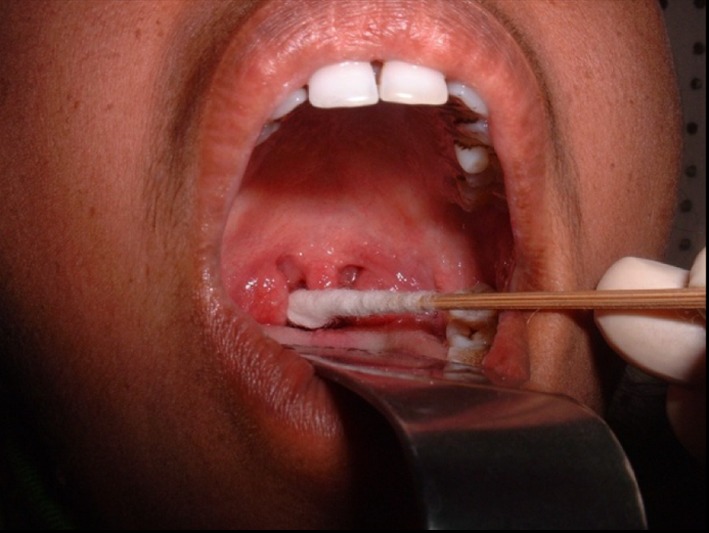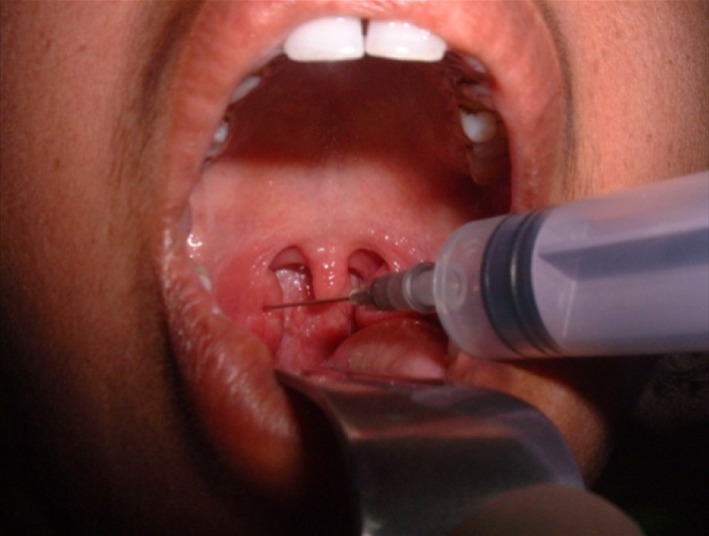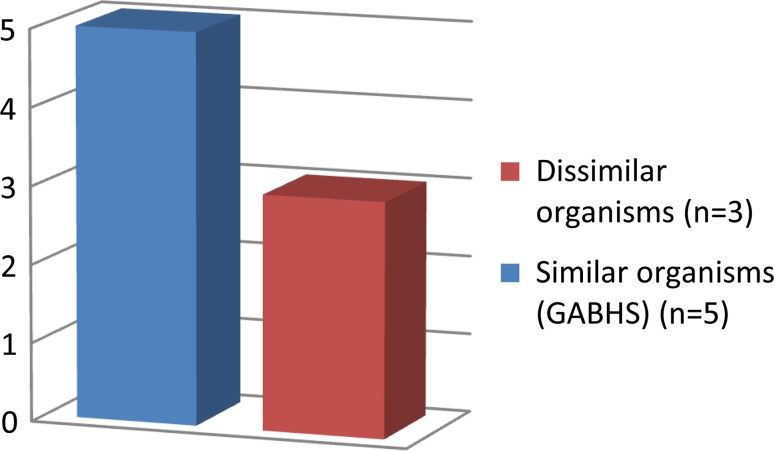Abstract
Serum Antistreptolysin O (ASO) titre is raised when there is infection of any organ of the body, by Group A beta haemolytic streptococci (GABHS), Group C or Group G streptococci [1]. Increased serum ASO titre should not be the only deciding criterion for tonsillectomy if GABHS is not present in the palatine tonsils. In this study, we evaluate the rationality of performing tonsillectomy in raised serum ASO titre only, in absence of GABHS in palatine tonsil. The study was designed as a prospective cohort study in which the main out come measure is to find out: The main outcome measure is to find out whether only the raised serum ASO titre is to be considered to perform tonsillectomy or not. Fifty consecutive patients (both children and adults) clinically diagnosed to have chronic tonsillitis were included in this prospective cohort study. Throat swab culture, tonsilar core tissue culture and Serum ASO titre tests were performed in all the patients. The results showed that out of the 50 patients 45 had raised ASO titre and 5 patients had normal ASO titre. GABHS was found in 5 cases (10 %) in throat swab culture and 8 cases (16 %) in FNA of tonsil core culture. The sensitivity of throat swab culture as compared to FNA Tonsil core culture was 62.5 % and positive predictive value was 100 %. The sensitivity of ASO titre as compared to core culture was 100 % and positive predictive value was 17.8 %. Specificity was only 12 %. From the results of this study, it is evident that FNA culture of the tonsil core is a valid and a reliable test for the diagnosis of bacterial micro flora in recurrent tonsillitis. One should perform throat swab culture and FNA culture from tonsil core along with ASO titre before doing tonsillectomy in absence of any other indications. Identifying GABHS in the tonsil by FNA test and/or in the throat swab culture along with high serum ASO titre may be one of the ideal indications for tonsillectomy.
Keywords: GABHS, Chronic tonsillitis, ASO titre, Throat swab culture, FNA of tonsil core culture
Introduction
Tonsillitis is a common disorder in children and to a lesser extent in the older age group. The life time prevalence of recurrent tonsillitis was 11.7 % with significant predominance of female cases. There is evidence for a substantial genetic predisposition for recurrent tonsillitis [2].On the other hand a virus may be the sole agent responsible [2]. Of the bacteria causing tonsillitis, Beta haemolytic Streptococci, Staphylococcus aureus, Haemophilius influenzae, Klebsiellae, Streptococci pneumoniae are the most common organisms. Of all these strains, Group A Beta haemolytic Streptococci (GABHS) is the only organism which gives rise to systemic complications in the form of Rheumatic heart disease, Glomerulonephritis, Arthritis eye diseases etc. But GABHS is only responsible for 5–15 % of all the sore throat cases .
Otolaryngologists, nowadays, consider tonsillectomy only in fewer indications like:
Obstructive sleep apnoea syndrome due to tonsilar enlargement
Neoplasms of the tonsil
- Recurrent tonsillitis (SIGN CRITERIA)
- Sore throat due to tonsillitis
- Five or more episodes of tonsillitis per year
- Symptoms for at least one year
- When the episodes of sore throat are disabling and prevent normal functioning.
Colonization in the tonsils by GABHS is also an important indication for tonsillectomy. To establish the carrier state of GABHS in the tonsils, different investigations have been advocated:
Throat swab culture
Fine needle aspiration (FNA) culture from the core of the tonsil
Serum anti Streptolysin O (ASO) titre
Core culture of the dissected tonsil (after tonsillectomy).
An infection with GABHS in the human body produces different toxins; Streptolysin O is one of them and antigenic in nature. As a normal immunological response, antibodies against it i.e. Anti-Streptolysin O (ASO), are detected in the serum after Group A Streptococcal infections. An increase in the serum ASO titre is possible after an infection with GABHS in any part of the body. Only 20 % cases of Rheumatic fever in early stage may present with normal ASO titre. Tuberculosis and liver disease may sometimes present with false positive ASO titre.
Aims and Objectives
To evaluate the validity of tonsillectomy in patients with raised serum ASO titre only and to correlate between the raised serum ASO titre, throat swab culture and FNA culture of tonsil.
Materials and Methods
This prospective study was conducted in the department of ENT and Head-Neck surgery, Vivekananda Institute of Medical Sciences, Ramakrishna Mission Seva Pratishthan, Kolkata. The patients were randomly selected from the ENT out-patient department between July 2008 to July 2010. Fifty consecutive patients (both children and adults) clinically diagnosed to have chronic tonsillitis were included in the study.
A detailed history of each subject was taken which included the chief complaints, history of present illness, history of past illness and their personal history. The onset, duration and progress of the symptoms were enquired upon. Serum ASO titre, throat swab cultures and Fine Needle Aspirations from the core of the tonsils under local anaesthesia were performed in all the patients. Consent for all these procedures were obtained from the patients and the guardians in case of children. Patients who had antimicrobial therapy for 4 weeks prior to surgery, an acute infection such as acute tonsillitis, peritonsillar abscess or suspected neoplasm were excluded from this study.
Determination of ASO titre
Geometric dilution of the patients’ sera were carried out by the tube dilution method [3]. The dilutions used were in the range from 1:100–1:744.
Throat Swab
Throat swabs were cultured for pyogenic organisms from the surface of the tonsil using sterile swab sticks (Fig. 1). Then the swab was immediately inoculated into nutrient agar, blood agar and McConkeys agar plates. Identification of the bacteria was done after isolation as per the standard procedure.
Fig. 1.

Throat swab being taken
FNAC of Tonsil Core
Fine Needle Aspirations of the tonsilar cores were performed using a 20 gauge needle which was fixed to a 10 ml sterile plastic syringe (Fig. 2). The needle was moved back and forth (approx depth 4 mm-6 mm) within the tonsil along the same plane [4]. The needle was then removed and the collected materials injected onto a sterile swab stick and sent for processing in a sterile culture tube. This procedure was done under local anaesthesia. Topical xylocaine spray (10 %) was used as an anaesthetic agent.
Fig. 2.

FNA being taken
In both the procedures the cultured organisms after isolation were recorded separately. A proforma was made for recording the details of each and every patient. Sensitivity and specificity of the tests were determined by using standard statistical methods. Approval from the Ethical committee of our institution was obtained for the project.
Results
The total number of patients in this study were 50 (n = 50) with ages ranging from 6 to 36 years. Of these 27 were males and 23 females. Out of 50 patients 45 showed raised ASO titre and 5 patients showed normal ASO titre. GABHS was found in 5 cases (10 %) in swab culture and 8 cases (16 %) in FNA tonsil core culture respectively.
Ten percent patients (5/50 patients) showed similar micro-organisms i.e. GABHS both in throat swab and in tonsil core culture. Dissimilar growth was found in three patients in FNA core culture and in these three patients throat swab culture showed Staphylococcus aureus (Fig. 3; Table 1).
Fig. 3.
Shows the result of GABHS in throat swab culture and tonsil core culture
Table 1.
Comparison between throat swab culture and tonsil core culture
| Throat swab culture | Tonsil FNA core culture | Total | |
|---|---|---|---|
| GABHS growth | Other micro-organism | ||
| GABHS growth | 05 | 00 | 05 |
| Other micro organism | 03 | 42 | 45 |
| Total | O8 | 42 | 50 |
The sensitivity of Throat swab culture as compared to Core culture was 62.5 % and the positive predictive value was 100 %.
Comparison between serum ASO titre and tonsil core culture shows that 45 out of 50 patients had raised ASO titre and only eight patients showed GABHS positive in core culture (Table 2).
Table 2.
Comparison between ASO titre and core culture
| ASO titre | Tonsil core FNA | Total | |
|---|---|---|---|
| +ve for GABHS | −ve for GABHS | ||
| Positive (>200 IU/ml) | 8 | 37 | 45 |
| Negative (≤200 IU/ml) | 0 | 5 | 5 |
| Total | 8 | 42 | 50 |
The sensitivity of ASO titre as compared to Core culture was 100 % and the positive predictive value was 17.8 %. Specificity was very low, only 12 %.
Discussion
Nowadays tonsillectomy is rarely performed for obvious reasons. Two to three decades back tonsillectomy was the main operation to be performed by the otolaryngologists. This may be due to engagement and involvement of the ENT surgeons in more and more micro-ear surgery, Head and Neck surgeries and other newly evolved surgeries like endoscopic sinus surgery, phonosurgery, skull base surgery etc.
However the indications for tonsillectomy have been considerably limited to a very few diseases. It has become a common tendency by some of us to decide about tonsillectomy on the basis of high serum ASO titre alone, without knowing about the presence of Group A beta-haemolytic streptococcus (GABHS) in the tonsils. Many a times we observe that the relevant tests do not show the growth of GABHS in patients having very high ASO titre in their serum. If tonsillectomy is done in these patients there won’t be any satisfactory improvement in symptoms. The observations and results of this study have highlighted that, if tonsillectomy is done in these patients, it would not help lower their serum ASO titre, nor will they improve symptomatically if chronic tonsillitis is due to any other reasons apart from GABHS infection.
To establish the upper respiratory tract carrier state in patients, different investigation modalities have been suggested in the literature [5, 6]. Of these, the throat swab culture and serum ASO titre are most commonly practiced.
Group A (S. Pyogenes) are one of the most important human pathogens. They cause disease by three mechanisms.
Pyogenic inflammation, which is induced locally at the site of the organism in the tissue,
Exotoxin production, which can cause widespread systemic symptoms in areas of the body where there are no organisms, and
Immunologic, which occurs when antibody against a component of the organism cross react with the normal tissue or form immune-complexes that damage normal tissues (heart muscle, kidney, skeletal joints etc.).
Group A organisms produce five important toxins and haemolysins. Streptolysin O is one of them and antigenic in nature. So antibodies to it i.e. ASO develop after Group A Streptococcal infections. An increase in the serum ASO titre is possible after an infection with GABHS, in any part of the body, even adenoids may harbour these pathogens [7]. Group C and Group G streptococci infrequently cause human disease and are not so important pathogens clinically. However Group C and Group G Streptococci are also responsible for a rise in the serum ASO titre [1]. Only the tonsils cannot be stamped responsible for the rise in the serum ASO titre. Moreover even after complete eradication of GABHS from the body by proper antimicrobial therapy, the serum ASO titre may remain raised for a considerable period of time due to the immunoglobulin G (IgG) nature of the antibody.
In this study the validity of the ASO titre was calculated. The sensitivity of the test was 100 % and the specificity was only 12 % and the positive predictive value was 17.8 %.
The specificity and positive predictive value of ASO titre were very poor. So this is not a valid test for identifying the presence of GABHS specifically in the tonsil alone (Table 2).
The diagnostic test of swabbing the surface of the tonsils as a culture specimen for determination of the organisms responsible for tonsillitis is well in practice but several studies indicate a marked discrepancy in the surface and core pathogens [8–12]. This study conforms with the statement by the above mentioned authors that the throat swab is not a reliable diagnostic test for identifying the bacterial micro flora in recurrent/chronic tonsillitis if it is not associated with high serum ASO titre and FNA culture. This study showed that the sensitivity and positive predictive value of throat swab culture were 83 and 92.8 % respectively (Table 1).
The gold standard for identifying the organisms is taken to be the dissected tonsilar core culture. Fine needle aspirations (FNA) provides equivocal histopathological diagnosis and has been popularized in medicine since the early 1980s. The role of FNA in recurrent/chronic tonsillitis had been reported by Timon et al. in 1991 and Kurien et al. in 2003. These studies showed a 100 % correlation between the FNA and dissected core culture. However, this procedure (FNA) was not popularised as there was a controversy regarding the tolerance of this procedure in awake patients. In all the patients in this study FNA of the tonsilar core was performed under local anaesthesia. From the analysis of this test it is evident that it has excellent sensitivity and positive predictive values. Besides this the patients have tolerated this procedure under local anaesthesia very well. In an article by Gaffney and Cafferkey the accuracy of this test has been suggested although not validated [4].
The role of ASO titre; throat swab culture and FNA culture in decision making for tonsillectomy has been depicted in Table 3.
Table 3.
Role of ASO titre; Throat swab culture and FNA culture in decision making for tonsillectomy
| ASO titre (IU/ml) | Throat swab culture | FNA culture | Tonsillectomy to be done (yes/no) |
|---|---|---|---|
| >200 | GABHS present | Not done | Yes |
| >200 | GABHS absent | GABHS present | Yes |
| >200 | GABHS absent | GABHS absent | No |
| <200 | GABHS present | GABHS present | Yes |
Microbiology of both surface and core of the tonsil in this study revealed that the most common isolated organism was StaphylococcusAureus followed by Group A Beta haemolytic Streptococcus and Haemophilus species. This conforms to the reports of Loganathan 2006 and Inci 2003. The use of surface swab culture (throat swab) failed to recognize GABHS in a significant number of patients in this study. This illustrates the basic therapeutic dilemma in using the results of ASO titre and throat swab culture for the treatment of recurrent/chronic tonsillitis.
Conclusion
Depending mainly on high serum ASO titre for tonsillectomy is neither reliable nor acceptable. From this study it is evident that FNA culture of the tonsil core is a valid and a reliable test for the diagnosis of bacterial micro flora in recurrent tonsillitis. One should perform throat swab culture and FNA culture along with ASO titre before doing tonsillectomy if no other indications are present. Identifying GABHS in the tonsil by FNA test and/or in the throat swab culture along with high serum ASO titre may be one of the ideal indications for tonsillectomy.
This test can be done safely under local anaesthesia in older children and adults as an out-patient procedure.
Acknowledgments
We acknowledge Swami Styadebanada Maharaj, Secretary, V.I.M.S. and R.K.M.S.P., Kolkata, for allowing us to do this research work in our department. We thank all the Departmental staffs including Department of Microbiology and patient who volunteer for this study.
References
- 1.Quinn RW, Lowry PN. The anatomical area of involvement in Streptococcal infection and the carrier state. Yele J Biol Med. 1970;43:10–16. [PMC free article] [PubMed] [Google Scholar]
- 2.Kvested E, Kvalrner KJ, Rocysamb E, Tambs K, Harris JR, Magner P. Division of epidemiology, Norwegian Institute of Public Health. Arch Otolaryngol Head Neck Surg. 2005;131:383–387. doi: 10.1001/archotol.131.5.383. [DOI] [PubMed] [Google Scholar]
- 3.Johnson DR, kaplan EL, Sramek J, Bicova R, Havlicekl J, Havlickova H, Motlova J, Kriz P. WHO manual on laboratory diagnosis of group A streptococcal infections. Geneva: World Health Organization; 1996. [Google Scholar]
- 4.Gaffney RJ, Cafferkey MT. Bacteriology of normal and diseased tonsils assessed by fine-needle aspiration: Haemophilus influenzae and the pathogenesis of recurrent acute tonsillitis. Clin Otolaryngol Allied Sci. 1998;23(2):181–185. doi: 10.1046/j.1365-2273.1998.00136.x. [DOI] [PubMed] [Google Scholar]
- 5.Loganathan A, Arumainathan UD, Raman R. Comparative study of bacteriology in recurrent tonsillitis among children and adults. Singapore Med J. 2006;47(4):271–275. [PubMed] [Google Scholar]
- 6.Karmarkar MG, Venugopal V, Joshi L, Kamboj R. Evaluation & revaluation of upper limits of normal values of anti-streptolysin O & anti-deoxyribonuclease B in Mumbai. Indian J Med Res. 2004;119(Suppl):26–28. [PubMed] [Google Scholar]
- 7.Ramirez A, Peidrola D, Lopez A, Martinez MD, Ros MJ, Corral JL, Arteaga E. Beta-hemolytic streptococci in tonsil hypertrophy and recurrent tonsillitis. Enferm Infecc Microbiol Clin. 1997;15(6):315–318. [PubMed] [Google Scholar]
- 8.Rosen G, Samuel J, Vered I. Surface tonsillar microflora versus deep tonsillar microflora in recurrent acute tonsillitis. J Laryngol Otol. 1977;91(10):911–913. doi: 10.1017/S0022215100084553. [DOI] [PubMed] [Google Scholar]
- 9.Kurien M, Stanis A, Job A, Brahmadathan, Thomas K. Throat swab in the chronic tonsillitis: how reliable and valid is it? Singapore Med J. 2000;41(7):324–326. [PubMed] [Google Scholar]
- 10.Brook I, Yocum P, Shah K. Surface vs core-tonsillar aerobic and anaerobic flora in recurrent tonsillitis. JAMA. 1980;244(15):1696–1698. doi: 10.1001/jama.1980.03310150032024. [DOI] [PubMed] [Google Scholar]
- 11.Timon CI, McAllister VA, Walsh M, Cafferkey MT. Changes in tonsillar bacteriology of recurrent acute tonsillitis: 1980 vs. 1989. Respir Med. 1990;84(5):395–400. doi: 10.1016/S0954-6111(08)80074-1. [DOI] [PubMed] [Google Scholar]
- 12.Robinson AC, Hanif J, Dumbreck LA, Prichard AJ, Manners BT. Throat swabs in chronic tonsillitis: a time-honoured practice best forgotten. Br J Clin Pract. 1997;51(3):138–139. [PubMed] [Google Scholar]



